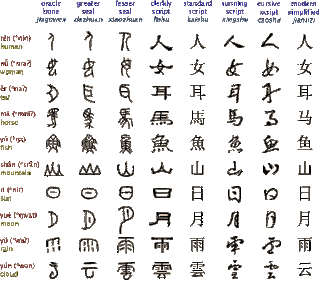The first four phases of Chinese writing trace the first 1,500-year history of Chinese and essentially encompass the evolution from a nascent pictographic and ambiguous writing script to a standardised system containing thousands of characters still in use today.
-Jiaguwen (甲骨文), or Oracle Bone Script. This is the earliest form of Chinese writing, used from the Middle to Late Shang dynasty (approximately 1500 BCE to 1000 BCE). This script was etched onto turtle shells and animals bones, which were then used for divination in the royal Shang court, hence the name "oracle bones". Consequently, scholars have been using oracle bones as historical documents to investigate the reigns of later Shang monarchs, and surprisingly confirming the veracity of the traditional list of Chinese emperors that was deemed mythological rather than historical. The shape of these characters are often described as "pictographic", in that they resemble stylised drawings of objects they represent.
-Dazhuan (大篆), or Greater Seal. This stage of Chinese writing flourished from the Late Shang to the Western Chou dynasties (1100 BCE to 700 BCE). Unlike Jiaguwen, which was carved on bones, Dazhuan mainly appeared on cast bronze vessels. In fact, Jiaguwen and Dazhuan overlapped in time, and they might have been the same script but as they were inscribed on different materials their visual styles differ due to the quality of the surfaces.
-Xiaozhuan (小篆), or Lesser Seal. This elegant script is the direct parent of the modern, unsimplified Chinese script. Not only are Xiaozhuan characters are more stylized and less "pictographic" like Jiaguwen and Dazhuan, but also exhibits systematic and extensive use of radicals much like modern Chinese. This script has survived the passage of time and continues to be used in the present age in calligraphy and seals.
-Lishu (隸書), or Clerkly Script. As its name implies, this script was used by government bureaucrats. While it probably appeared at approximately 500 BCE, Lishu became widely used in the Qin (221 to 207 BCE) and Han (206 BCE to 220 CE) dyansties when the bureaucrats needed a fast and efficient script to handle state matters. The marked difference between this script and the Xiaozhuan is that Li Shu characters have less strokes and a more flowing style, therefore easily adaptable to brushes and pens. Lishu is still occassionally used in the modern age.
-Kaishu (楷書), or Standard Script, is essentially the traditional script used today (except in the People's Republic of China). It is very similar to Lishu, but slightly more cursive and contains serif-like (hook or anchor-like) elements at the corners and end of strokes. Kaishu appeared toward the end of the Han dynasty (220 CE).
-Xingshu (行書), or Running Script, can be considered a cursive version of Kaishu. Often several strokes are merged into one, especially sequential dots or two strokes perpendicular to each other. It also appeared shortly after the Han dynasty.
-Caoshu (草書), or Grass Script, is the most cursive Chinese script. It appeared during the Qin dynasty. The shape of its characters often do not resemble the corresponding Lishu or Kaishu character, in that some strokes are merged into one and others are simply left out.
Basically, the word we are writing nowadays were mainly transformed from Lishu and Kaishu due to the fact that they have less strokes and a more flowing style, therefore easily adaptable to brushes and pens

No comments:
Post a Comment